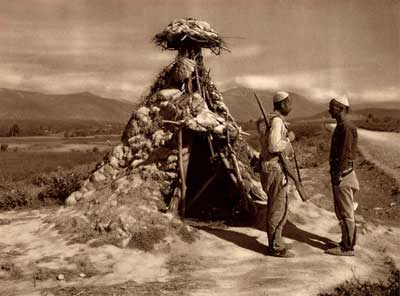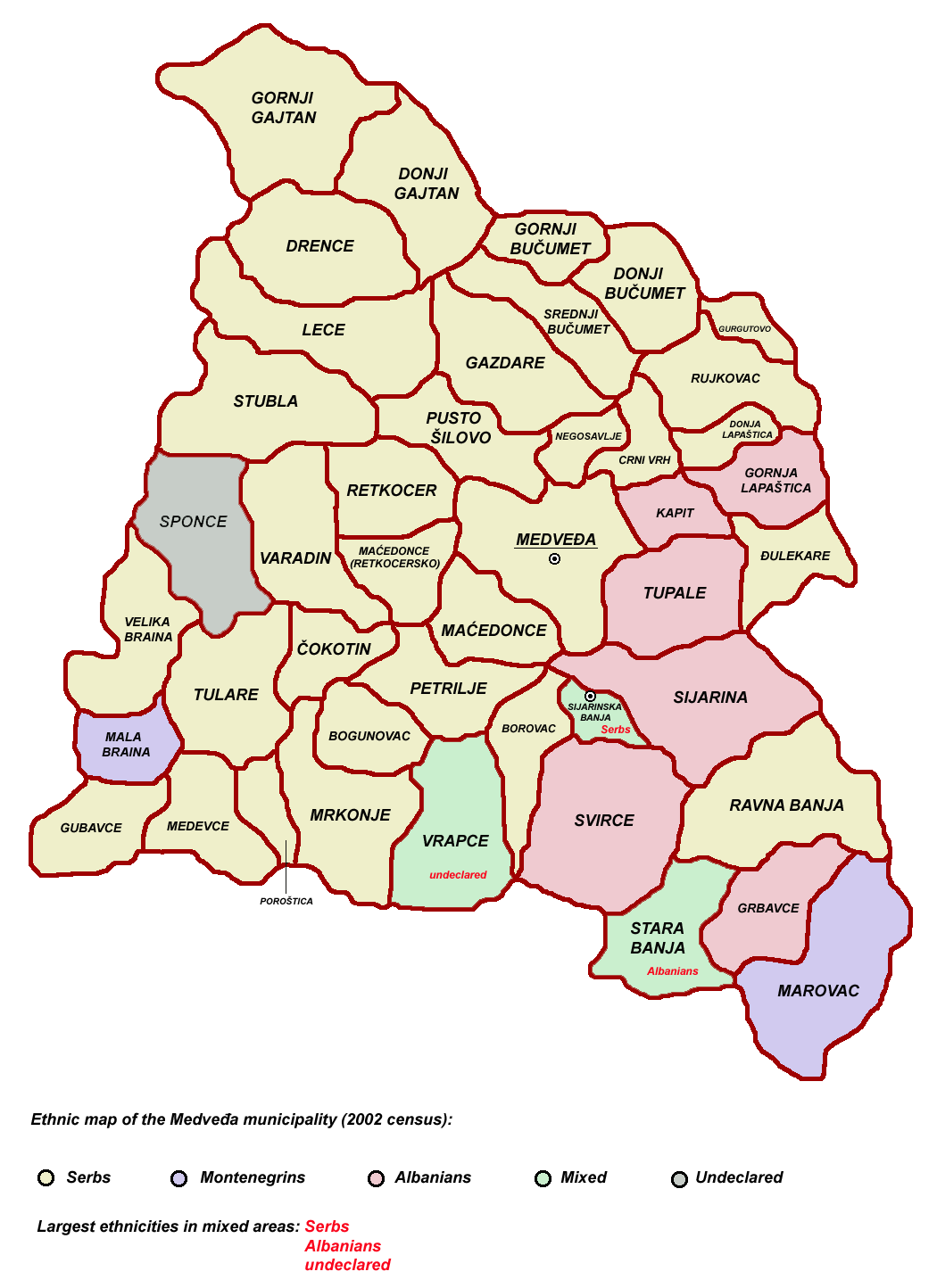|
Ajet Sopi Bllata
Ajet Sopi Bllata (1861–1938) was an Albanian rebel from the village of Jabllanica, in present-day Bujanovac municipality, then part of the Ottoman Empire. From the age of 17 to that of 53, he fought as a kachak against Serbian interests in the Kosovo Vilayet. He spend his later life in the Kavajë area where many Kosovo Albanian refugees settled after Serbia annexed Kosovo in 1912. Life He was from the same family as rebel Ahmet Sopi. When he was 17, control of Jabllanica was transferred to the Principality of Serbia, which had gained it after the Congress of Berlin. His village was burnt and looted and the villagers turnt into refugees during the expulsion of Albanians from the newly acquired areas. For Ajet Sopi, this was the formative event of his life. He would spend much of his life after these events as a kachak against Serbia. Sopi fought as a Kachak for many years against Serbs together with Idris Seferi until he was expelled by Chetniks to Turkey. Eventually he mo ... [...More Info...] [...Related Items...] OR: [Wikipedia] [Google] [Baidu] |
Albanians
The Albanians (; sq, Shqiptarët ) are an ethnic group and nation native to the Balkan Peninsula who share a common Albanian ancestry, culture, history and language. They primarily live in Albania, Kosovo, North Macedonia, Montenegro, Serbia as well as in Croatia, Greece, Italy and Turkey. They also constitute a large diaspora with several communities established across Europe, the Americas and Oceania. Albanians have Paleo-Balkanic origins. Exclusively attributing these origins to the Illyrians, Thracians or other Paleo-Balkan people is still a matter of debate among historians and ethnologists. The first certain reference to Albanians as an ethnic group comes from 11th century chronicler Michael Attaleiates who describes them as living in the theme of Dyrrhachium. The Shkumbin River roughly demarcates the Albanian language between Gheg and Tosk dialects. Christianity in Albania was under the jurisdiction of the Bishop of Rome until the 8th century AD. Then, dioceses ... [...More Info...] [...Related Items...] OR: [Wikipedia] [Google] [Baidu] |
Jablanica, Bujanovac
Jablanica ( sr-cyrl, Јабланица) is a village in the municipality of Bujanovac, Serbia. According to the 2002 census, the town has a population of 109 people.Popis stanovništva, domaćinstava i Stanova 2002. Knjiga 1: Nacionalna ili etnička pripadnost po naseljima. Republika Srbija, Republički zavod za statistiku Beograd 2003. Notable people *Ajet Sopi Bllata Ajet Sopi Bllata (1861–1938) was an Albanian rebel from the village of Jabllanica, in present-day Bujanovac municipality, then part of the Ottoman Empire. From the age of 17 to that of 53, he fought as a kachak against Serbian interests in t ..., Albanian rebel References Populated places in Pčinja District {{PčinjaRS-geo-stub ... [...More Info...] [...Related Items...] OR: [Wikipedia] [Google] [Baidu] |
Bujanovac
Bujanovac ( sr-cyr, Бујановац, ; sq, Bujanoc) is a town and municipality located in the Pčinja District of southern Serbia. Situated in the South Morava basin, it is located in the geographical area known as Preševo Valley. It is also known for its source of mineral water and spa town ''Bujanovačka.'' ''Albanians'' are the largest ethnic group in the town, also the largest ethnic group in the municipality are Albanians. History Ancient history Kale-Krševica, located south of Ristovac, is an archaeological site of a 5th-century BC Ancient city of Macedon, thought to be Damastion. The Thracian Triballi and Paeonian Agrianes dwelled in the region, with the Scordisci settling here after the Gallic invasion of the Balkans in 279 BC. The region was conquered by the Romans after 75 BC. It became part of the Roman propraetorial province Moesia in 29 BC (imperial from 27 BC). In 87 AD the region was re-organized into the Moesia Superior, which was a province of the Rom ... [...More Info...] [...Related Items...] OR: [Wikipedia] [Google] [Baidu] |
Ottoman Empire
The Ottoman Empire, * ; is an archaic version. The definite article forms and were synonymous * and el, Оθωμανική Αυτοκρατορία, Othōmanikē Avtokratoria, label=none * info page on book at Martin Luther University) // CITED: p. 36 (PDF p. 38/338) also known as the Turkish Empire, was an empire that controlled much of Southeast Europe, Western Asia, and Northern Africa between the 14th and early 20th centuries. It was founded at the end of the 13th century in northwestern Anatolia in the town of Söğüt (modern-day Bilecik Province) by the Turkoman tribal leader Osman I. After 1354, the Ottomans crossed into Europe and, with the conquest of the Balkans, the Ottoman beylik was transformed into a transcontinental empire. The Ottomans ended the Byzantine Empire with the conquest of Constantinople in 1453 by Mehmed the Conqueror. Under the reign of Suleiman the Magnificent, the Ottoman Empire marked the peak of its power and prosperity, as well a ... [...More Info...] [...Related Items...] OR: [Wikipedia] [Google] [Baidu] |
Kachak
Kachaks ( sq, kaçak, sr, качаци / ''kačaci'') is a term used for the Albanian bandits active in the late 19th and early 20th century in northern Albania, Montenegro, Kosovo and Macedonia, and later as a term for the militias of Albanian revolutionary organizations against the Kingdom of Serbia (1910–18) Kingdom of Yugoslavia (1918–24), called the "Kaçak movement". Etymology The word is derived from Turkish '' kaçmak'' for "outlaw". Background History 1920–24 Kachak movement The Committee for the National Defense of Kosovo () was created in Shkodër, under Hasan Prishtina, in 1918. The committee organizationally and financially supported the kachaks in Albanian-populated areas of Yugoslavia, in Kosovo and Skopje (the former Kosovo Vilayet). Kachaks were also active around Ohrid and Bitola. On 6 May 1919 the Committee called for a general uprising in Kosovo and other Albanian-inhabited regions in Yugoslavia. The Kachaks were popular among Albanians, and local s ... [...More Info...] [...Related Items...] OR: [Wikipedia] [Google] [Baidu] |
Kavajë
Kavajë ( , sq-definite, Kavaja) is a municipality centrally located in the Western Lowlands region of Albania, in Tirana County. It borders Durrës to the north , Tiranë to the east and Rrogozhinë to the south . To the west lies the Adriatic Sea. Based on the 2011 Census, the municipality had a population of 40,094 inhabitants, although the Civil Registry inferred the total number of inhabitants to be 79,556. The overall surface area is . Etymology The name Kavajë is mentioned in Ottoman archives from the Land Registry of the Sanjak of Albania for the years 1431–1432. In the documents, first published by Turkish researcher Halil İnalcık this locality was part of. On Latin Maps it was mentioned as Cavalli (Horses in Italian) History Early development There have been varied opinions on the origin of Kavajë as an inhabited settlement. Until recently, researchers believed the early beginnings of this region as a settlement should be sought somewhere in the middle ... [...More Info...] [...Related Items...] OR: [Wikipedia] [Google] [Baidu] |
Principality Of Serbia
The Principality of Serbia ( sr-Cyrl, Књажество Србија, Knjažestvo Srbija) was an autonomous state in the Balkans that came into existence as a result of the Serbian Revolution, which lasted between 1804 and 1817. Its creation was negotiated first through an unwritten agreement between Miloš Obrenović I, Prince of Serbia, Miloš Obrenović, leader of the Second Serbian Uprising, and Ottoman Empire, Ottoman official Marashli Pasha. It was followed by the series of legal documents published by the Sublime Porte in 1828, 1829 and finally, 1830—the Hatt-i Sharif. Its ''de facto'' independence ensued in 1867, following the evacuation of the remaining Ottoman troops from the Belgrade Fortress and the country; its independence was recognized internationally in 1878 by the Treaty of Berlin (1878), Treaty of Berlin. In 1882 the country was elevated to the status of Kingdom of Serbia, kingdom. Background and establishment The Serbian revolutionary leaders—first Karađ ... [...More Info...] [...Related Items...] OR: [Wikipedia] [Google] [Baidu] |
Congress Of Berlin
The Congress of Berlin (13 June – 13 July 1878) was a diplomatic conference to reorganise the states in the Balkan Peninsula after the Russo-Turkish War of 1877–78, which had been won by Russia against the Ottoman Empire. Represented at the meeting were Europe's then six great powers: Russia, Great Britain, France, Austria-Hungary, Italy and Germany; the Ottomans; and four Balkan states: Greece, Serbia, Romania and Montenegro. The congress concluded with the signing of the Treaty of Berlin, replacing the preliminary Treaty of San Stefano that had been signed three months earlier. The leader of the congress, German Chancellor Otto von Bismarck, sought to stabilise the Balkans, reduce the role of the defeated Ottoman Empire in the region, and balance the distinct interests of Britain, Russia and Austria-Hungary. He also wanted to avoid domination of the Balkans by Russia or the formation of a Greater Bulgaria, and to keep Constantinople in Ottoman hands. Finally Bismarck ... [...More Info...] [...Related Items...] OR: [Wikipedia] [Google] [Baidu] |
Expulsion Of The Albanians, 1877–1878
The Expulsion of Albanians 1877–1878 refers to events of forced migration of Albanian populations from areas that became incorporated into the Principality of Serbia and Principality of Montenegro in 1878. These wars, alongside the larger Russo-Ottoman War (1877–78) ended in defeat and substantial territorial losses for the Ottoman Empire which was formalised at the Congress of Berlin. This expulsion was part of the wider persecution of Muslims in the Balkans during the geopolitical and territorial decline of the Ottoman Empire. On the eve of conflict between Montenegro and the Ottomans (1876–1878), a substantial Albanian population resided in the Sanjak of İşkodra. In the Montenegrin-Ottoman war that ensued, strong resistance in the towns of Podgorica and Spuž toward Montenegrin forces was followed by the expulsion of their Albanian and Slavic Muslim populations who resettled in Shkodër. On the eve of conflict between Serbia and the Ottomans (1876–1878), a substan ... [...More Info...] [...Related Items...] OR: [Wikipedia] [Google] [Baidu] |
Gjilane
Gjilan, or Gnjilane ( sr-cyr, Гњилане) is the eighth largest List of cities and towns in Kosovo, city in Autonomous_Province_of_Kosovo_and_Metohija, Kosovo and seat of Gjilan Municipality and District of Gjilan, Gjilan District. Name Ottoman chronicler Evliya Çelebi mentions ''Morava'' as a settlement of the Sanjak of Vučitrn. Çelebi writes that: "The seventeen day journey from Constantinople (Istanbul) to pass through Vranje, Novo Brdo, Kriva Reka (Kosovo), Kriva Reka (Egridere) and Morava (Gjilan). The etymology of Gjilan is disputed. Albanian language, Albanian sources claim that the town (initially a village) obtained its name from Bahti Beg Gjinolli of Gjinaj clan that ruled the region of Vushtrri (Llap (region), Llap and Drenica), and populated this area in the 18th century (around 1750). History In 1342, a place called Morava was visited by Serbs, Serbian King Stefan Dušan (later Emperor of Serbia, Emperor, r. 1331–1355).Kostić 1922, p. 126 Gradiš ... [...More Info...] [...Related Items...] OR: [Wikipedia] [Google] [Baidu] |
Anamorava
Anamorava ( sq, Anamoravë) or Kosovo Pomoravlje ( sr, Косовско Поморавље / ''Kosovsko Pomoravlje'', " Pomoravlje of Kosovo"), is a valley in the Republic of Kosovo, in the southern part of the District of Gjilan surrounding the Morava e Binçës River. It stretches eastward to the Preševo Valley in southern Serbia. The mountains in this region, rising to an altitude of , border the Karadak region in north of Skopje. Gjilan, Kamenica, Novobërdë and Viti are municipalities located in the region. The region gave its name to Kosovo-Pomoravlje District, which largely corresponds to its successor District of Gjilan in the Republic of Kosovo. It is known for recording the lowest temperature in Kosovo: , on 25 January 1963. Name The region is known as ''Kosovsko Pomoravlje'' (, "Morava Valley of Kosovo") in Serbian and as ' ("Valley of Binač Morava") in Albanian. Its name is derived from the Binačka Morava (Morava e Binçës) River, which flows through norther ... [...More Info...] [...Related Items...] OR: [Wikipedia] [Google] [Baidu] |

.jpg)


